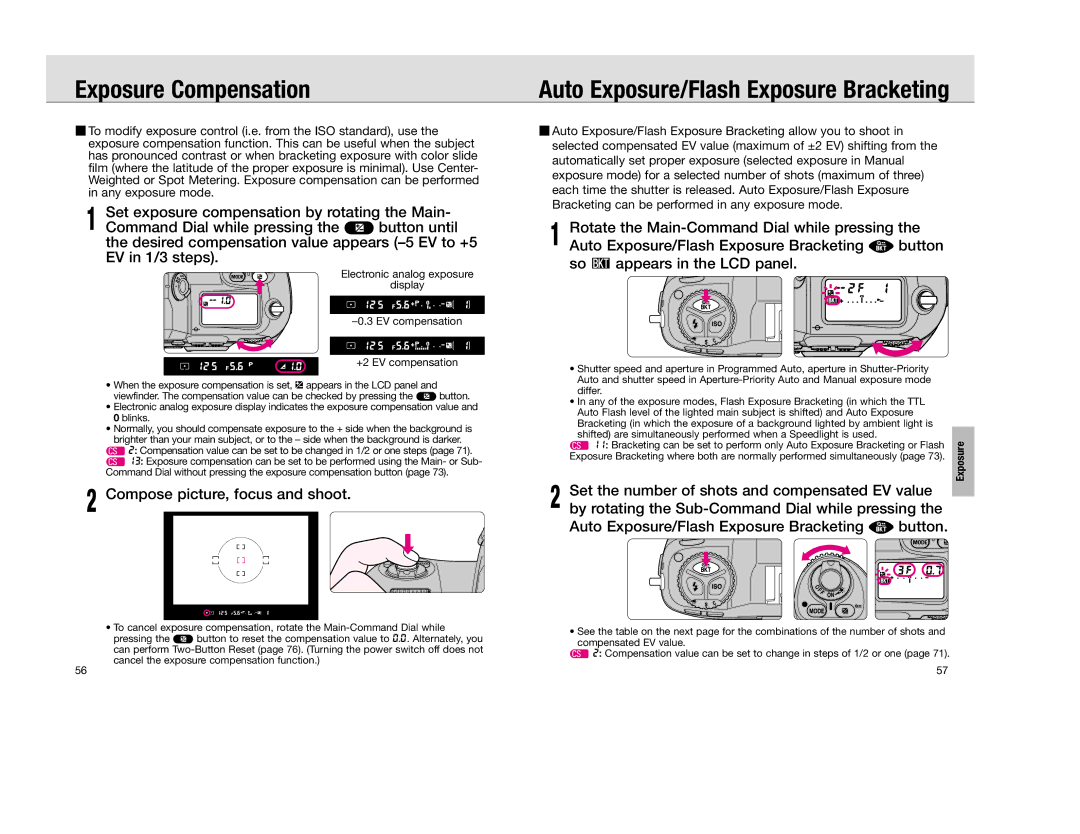
Exposure Compensation
•To modify exposure control (i.e. from the ISO standard), use the exposure compensation function. This can be useful when the subject has pronounced contrast or when bracketing exposure with color slide film (where the latitude of the proper exposure is minimal). Use Center- Weighted or Spot Metering. Exposure compensation can be performed in any exposure mode.
1 Set exposure compensation by rotating the Main- Command Dial while pressing the ˚ button until the desired compensation value appears
Electronic analog exposure
display
+2 EV compensation
•When the exposure compensation is set, = appears in the LCD panel and viewfinder. The compensation value can be checked by pressing the ˚ button.
•Electronic analog exposure display indicates the exposure compensation value and 0 blinks.
•Normally, you should compensate exposure to the + side when the background is brighter than your main subject, or to the – side when the background is darker.
·2: Compensation value can be set to be changed in 1/2 or one steps (page 71).
·13: Exposure compensation can be set to be performed using the Main- or Sub- Command Dial without pressing the exposure compensation button (page 73).
2 Compose picture, focus and shoot.
•To cancel exposure compensation, rotate the
Auto Exposure/Flash Exposure Bracketing
•Auto Exposure/Flash Exposure Bracketing allow you to shoot in selected compensated EV value (maximum of ±2 EV) shifting from the automatically set proper exposure (selected exposure in Manual exposure mode) for a selected number of shots (maximum of three) each time the shutter is released. Auto Exposure/Flash Exposure Bracketing can be performed in any exposure mode.
1Rotate the
•Shutter speed and aperture in Programmed Auto, aperture in
•In any of the exposure modes, Flash Exposure Bracketing (in which the TTL Auto Flash level of the lighted main subject is shifted) and Auto Exposure Bracketing (in which the exposure of a background lighted by ambient light is shifted) are simultaneously performed when a Speedlight is used.
· 11: Bracketing can be set to perform only Auto Exposure Bracketing or Flash | Exposure | |
Exposure Bracketing where both are normally performed simultaneously (page 73). | ||
|
2 Set the number of shots and compensated EV value by rotating the
• See the table on the next page for the combinations of the number of shots and compensated EV value.
·2: Compensation value can be set to change in steps of 1/2 or one (page 71).
56 | 57 |
